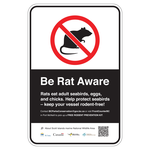Activity
-
ArticleSome boating tips to protect seabird breeding habitats from invasive, non-native rodents. see more
Boating in British Columbia can be an exhilarating experience. The abundance of sea life, rugged and rocky coastlines, and soaring mountain backdrops set the stage for memories that last a lifetime.
Many of our islands are recognized globally as important seabird breeding habitat. The Scott Islands are an example, which hosts 90% of Canada’s Tufted Puffins and 74% of Canada’s Cassin’s Auklets, which equates to 55% of the global population of this bird species.
Yet despite the seemingly endless numbers of marine birds on our coast, these numbers are not infinite. There is a pressing need to protect some of the largest breeding colonies from the greatest threat to their persistence – that of invasive, non-native rodents such as rats.
When rats are accidentally introduced to islands, they feed on the eggs and chicks of seabirds, and have been found to eat adult birds as well. The result of these rodent introductions is often the catastrophic loss of seabirds, and potentially complete bird extinctions as has been found in New Zealand and other oceanic islands.
Offshore islands contain a large amount of the world’s biodiversity. Sadly, most bird extinctions worldwide have occurred on such islands. Seabirds habitually concentrate in large numbers to breed on certain islands and so the effect of rodent introductions can be devastating to the species overall.
However, there is hope! We can all do our part to protect seabirds in BC from the accidental introduction of invasive rodents – by practicing sound biosecurity on your boat.
Fortunately, biosecurity methods are simple and reliable, if they are followed consistently:
- Firstly, check your boat for signs of rodents.
- Set snap-traps on board your boat several days before departing land.
- Start by placing baited, yet unset traps for 24 hours, followed by actually setting the traps and leaving them for an additional 24 hours. This will let the rodents become accustomed to the raps before they are set, thus reducing trap inhibition and making them more effective.
- If you find a live rodent on your boat, never throw it overboard. Rats can swim upwards of 800m, so even if you don’t land on an island, a rat can get ashore on its own when you least expect it.
- Without being aware, rats could have boarded your boat by scurrying up a line or jumping from the dock or another boat. Prevent this by installing rodent guards on your tie-up lines when you dock your boat.
You can collect FREE biosecurity rodent prevention kits at the FrontCounter BC office in Port McNeill, or contact BC Parks (BCParksConservation@gov.bc.ca) or Environment and Climate Change Canada (ec.rnfis-sinwa.ec@canada.ca) for more information about this important biosecurity project.
-
ArticleSafe and green refueling tips for boaters. see more
GAS UP. GREEN UP. REFUELING TIPS FOR BOATERS
Almost 700,000 people in BC enjoy recreational boating today. With more joining in every year, it becomes even more important to minimize our marine footprint, and to protect the sensitive creatures that call water home. It starts with safe and careful refueling.
We talked to Mike Short, CMM, owner of Vancouver based False Creek Fuels, Marina Manager at Clean Marine BC Certified Vancouver Marina, and Boating BC Board member – about what every boater can do be safe and green when refueling. Marinas certified by the Georgia Strait Alliance's Clean Marine BC Program are committed to adopting environmentally sound management principles and operating practices like eliminating the release of contaminants into the ocean, minimizing pollutants and adopting waste reduction and recycling strategies.
“Just a half litre of spilled oil can cover an acre of surface water,” says Mike. “Owners are responsible for fueling their own boats, so it’s important to know how to refuel properly, and to follow all the regulations posted at marinas.”
According to Mike the most common mistakes boaters make - especially new ones - include not knowing which is the right port for fuel. their fuel tank capacity, and the flow rate their boat can accept. Most pumps accommodate the faster flow rates required to fill commercial vessels, and “kickback” or “burping” is a major source of fuel spills - so it’s important to go slowly. If it’s your first time refueling, review the rules, and ask the attendant for help.
He also emphasizes the importance of closing all doors and hatches to keep explosive fumes from blowing into the bilge, and making sure you get the correct type of fuel - to double verify - before you put it into your boat.
Clean Up
When you do have a spill - even a dribble - clean up it immediately and thoroughly. Most marinas have containment equipment such as hydrocarbon absorbing spill pads handy. Just make sure you dispose of any used spill materials as hazardous waste. And never use soap to clean up a spill: it is illegal, doesn’t work and is toxic to marine life.
Mike’s final word? Mistakes happen so pay attention, don’t rush through the process – and keep yourself and your marine environment safe.
For more tips on being a green boater, click here.
Safe Refueling Tips
Before:
- Tie your boat securely to the fuel dock, and ask all passengers to go ashore
- Turn off your engine, and close all hatches, doors and windows
- Turn off all electrical equipment, and extinguish all flames (propane equipment, diesel furnaces, etc.)
- Keep an absorbent rag, spill pad or fuel collar ready to catch any drips
- Locate and select your fuel fill port (versus others like water and waste)
- Double check: the type of fuel you need, and the capacity of your boat.
During:
- Start fueling slowly - fuel can dispense at rates too fast for your boat
- Keep the fuel nozzle in contact with the fill port (or risk a static spark)
- Listen: Once your fuel is near capacity, you will hear a change in sound, or a gurgling
- Do not “top off” the tank, or risk a spill
- Clean up any drops or spills immediately.
After:
- Start your blower, open the engine hatch to sniff for fumes, and check the bilge
- Once the boat is safe and free of any explosive fumes, ask your passengers to reboard.
Note: Make sure you are on the shore when filling portable tanks, and when transferring fuel between tanks. Carry reserve fuel in a container that connects to your engine.
Did you know?
- If every one of the 200,000 boats on the coast spilled just a half litre, the oil slick would cover over 800 square kilometres!
- There have been studies in recent years suggesting that the small spills at marine fuel pumps result in as much - if not more - fuel residue in the waters than the commercial boating sector.
- Chemicals present in fuel react with sunlight to become up to 50,000 times more toxic.
- Source: The Georgia Strait Alliance


